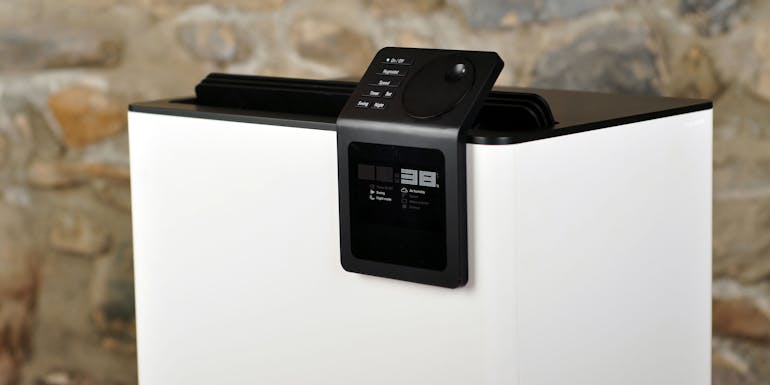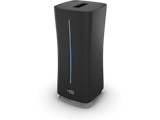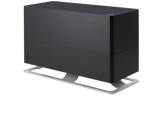
Nadine Walder, 25 November 2022
Measure humidity
What does a hygrostat do and when is one useful?
The terms “hygrometer” and “hygrostat” are both commonly used in the context of measuring relative air humidity. A hygrometer is a measuring instrument that measures the relative humidity of a room. But what is a hygrostat and why do you need one? The purpose of a hygrostat is to automatically control air humidity. This article will explain exactly what a hygrostat is, what they are used for and what their benefits are.
What is a hygrostat: Definition and uses
A hygrostat is a sensor. They can be bought separately to control humidifiers and dehumidifiers or they can be built in already. A hygrostat measures and controls the relative humidity of a room. The device has two components: a measuring sensor and a switch to control the humidifier or dehumidifier.
Hygrostats are used in air humidification and dehumidification. They allow the desired humidity to be controlled. They also favour energy efficiency by ensuring that humidifiers and dehumidifiers only run until the desired humidity level is achieved. The hygrostat then automatically switches the humidifier or dehumidifier off.
Different humidification systems are available. Some devices absolutely require a hygrostat to be built in, others less so. Ultrasonic mist humidifiers and vaporisers are active humidifiers and can cause excessive humidification. To prevent damage, the humidification output of these devices needs to be monitored, or controlled with a hygrostat. On the other hand, evaporative humidifiers are self-controlling systems. They use as much moisture as the air needs at the current temperature. Therefore, hygrostats aren’t absolutely necessary in evaporative humidifiers, as there is no risk of excessive humidification.
A built-in hygrostat is also highly recommended in dehumidifiers to ensure that the air doesn’t get too dry.
You should check whether or not the model has a built-in hygrostat before buying a humidifier or dehumidifier. If there isn’t one, you should consider buying a separate hygrostat to control the humidification. Otherwise think about keeping an eye on the humidity yourself and switching the humidifier or dehumidifier off when necessary so that the air doesn’t get too humid or dry.
How a hygrostat works
A hygrostat works in a very similar way to a thermostat. Whereas a thermostat ensures the optimal room temperature, a hygrostat ensures the ideal humidity level of a room. Thermostats compare the measured room temperature with a pre-defined setpoint. If the temperature increases above the setpoint, the thermostat switches the heating off. If the temperature drops below the setpoint, the thermostat switches the heating back on. A hygrostat does the same with humidity. The hygrostat automatically switches the humidifier off as soon as the relative humidity exceeds the setpoint. In the case of dehumidification, the hygrostat automatically switches the dehumidifier off when the humidity drops below the setpoint.
Unlike temperature, humans don’t generally have a good sense of humidity. If our home becomes warmer or cooler, we usually feel it sooner or later. But we don’t really feel it when the humidity changes. Nevertheless, air that is too moist or too dry can be harmful to health. That’s why it’s important to ensure a constant, ideal humidity level. We generally recommend a relative humidity level of 40% to 60% in living rooms and workspaces. Automatic control of your humidifier or dehumidifier will help with this and much more.
Ideal humidity with efficient energy use
Humidifiers and dehumidifiers fitted with a hygrostat keep rooms at a constant optimal humidity level. The big advantage of devices with a built-in hygrostat is that you don’t have to control the humidity yourself. You can simply enjoy a constant, healthy and pleasant room climate. A built-in hygrostat prevents the air from getting excessively humid or dry. Because humidifiers and dehumidifiers are then only switched on when you really need them, you don’t use any unnecessary electricity.
The air is often too damp or moist in cellars and drying rooms. A dehumidifier with hygrostat takes care of this and automatically switches on when the humidity is too high. Once the setpoint is reached, the dehumidifier automatically switches off again. This helps avoid a daily trip to the cellar and you can nevertheless be sure of an ideal level of humidity there.
If the air becomes too dry in winter, a hygrostat will automatically switch on your humidifier, ensuring the ideal level of humidity. The humidifier will automatically switch off as soon as the desired humidity is reached, eliminating the risk of excessive humidification.
Individual setting options according to preference
A big plus point is that you can set the hygrostat to your preferred humidity level. Therefore, most of our Stadler Form humidifiers and all of our dehumidifiers come with this function integrated. As mentioned before, evaporative humidifiers don’t actually need hygrostats. Nevertheless, many of our customers like being able to choose the relative humidity level themselves and have the device automatically switched off when the setpoint is reached.
A hygrostat lets you choose what your ideal humidity level is. For example, with our humidifiers Karl and Karl big you are free to choose a humidity level between 40–55%. Our dehumidifier TheoTheo also lets you select your preferred relative humidity of 40%, 50% or 60%. Finally, our 2-in-1 humidifier and air purifier George can be set to a humidity level of 40%, 45%, 50% or 55% . A device with a hygrostat is the right choice!
If you have questions related to indoor room climate, please get in touch with us. Or subscribe to our newsletter to regularly get informed about current topics regarding indoor climate, experience reports or Stadler Form insights.












